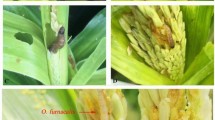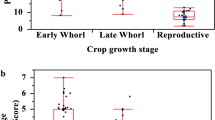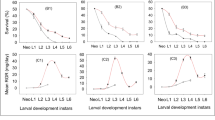Abstract
Exotic invasive insect herbivores have the potential to interfere with existing herbivore-natural enemy interactions in new environments. Fall armyworm (FAW), Spodoptera frugiperda J.E. Smith (Lepidoptera: Noctuidae), is a new invasive pest in maize fields in Africa. Understanding the acceptability and suitability of FAW to existing maize stemborer-parasitoid interactions is the first step in elucidating the impact that this exotic insect pest can have on the existing natural enemies used in biological control of maize stemborers in Kenya. The most commonly used larval parasitoids for biological control programs against maize stemborer communities in East Africa are Cotesia flavipes Cameron (Hymenoptera: Braconidae) and two populations of the native Cotesia sesamiae (Cs-Inland and Cs-Coast) Cameron (Hymenoptera: Braconidae). All these parasitoid species attacked FAW larvae but none yielded offspring, although they induced high non-reproductive host mortality when compared to natural mortality. Furthermore, the parasitoids that inserted their ovipositor into FAW larvae exhibited no significant preference between FAW larvae and their respective stemborer hosts under dual-choice bioassays. In olfactometer bioassays, the parasitoids were more attracted to plants infested by FAW than uninfested plants and even showed a marked preference for the odours of plants infested by FAW over those of plants infested by their natural host counterparts. This study illustrates that exotic pests, such as FAW, can impact existing stemborer-parasitoid interactions associated with maize, even if they cannot be used as hosts by parasitoids associated with these stemborers. Although additional studies are needed, FAW might therefore have a negative impact on stemborer biological control existing before its invasion.


Similar content being viewed by others
Data availability
Data will be made available after the manuscript accepted.
Change history
02 November 2020
A Correction to this paper has been published: https://doi.org/10.1007/s10526-020-10064-5
References
Abbott WS (1925) A method of computing the effectiveness of an insecticide. J Econ Entomol 18:265–267
Abram PK, Brodeur J, Urbaneja A, Tena A (2019) Nonreproductive effects of insect parasitoids on their hosts. Annu Rev Entomol 64:259–276
Abram PK, Gariepy TD, Boivin G, Brodeur J (2014) An invasive stink bug as an evolutionary trap for an indigenous egg parasitoid. Biol Invasions 16:1387–1395
Bernal JS, Luck RF, Morse JG, Drury MS (2001) Seasonal and scale size relationships between Citricola scale (Homoptera: Coccidae) and its parasitoid complex (Hymenoptera: Chalcidoidea) on San Joaquin valley citrus. Biol Control 20:210–221
Bichang’a G, Da Lage J-L, Sambai K, Mule S, Le Ru B, Kaiser L, Juma G, Maina EN, Calatayud P-A (2018) Salivary α-amylase of stem borer hosts determines host recognition and acceptance for oviposition by Cotesia spp (Hymenoptera, Braconidae). Front Ecol Evol 6:228
Buchori D, Sahari B, Ratna ES (2009) Encapsulation and hemocyte numbers in Crocidolomia pavonana and Spodoptera litura Fabricius (Lepidoptera) attacked by parasitoid Eriborus argenteopilosus Cameron (Hymenoptera). Hayati J Biosciences 16:135–141
Chabaane Y, Laplanche D, Turlings TC, Desurmont GA (2015) Impact of exotic insect herbivores on native tritrophic interactions: a case study of the African cotton leafworm, Spodoptera littoralis and insects associated with the field mustard Brassica rapa. J Ecol 103:109–117
Chau A, Mackauer M (2000) Host-instar selection in the aphid parasitoid Monoctonus paulensis (Hymenoptera: Braconidae, Aphidiinae): a preference for small pea aphids. Eur J Entomol 97:347–353
De Groote H, Kimenju SC, Munyua B, Palmas S, Kassie M, Bruce A (2020) Spread and impact of fall armyworm (Spodoptera frugiperda J. E. Smith) in maize production areas of Kenya. Agric Ecosyst Environ 292:106804
De Pedro L, Beita F, Asis JD, Tormos J (2018) Pseudoparasitism by Spalangia cameroni (Hymenoptera: Pteromalidae) of pupae of Ceratitis capitata (Diptera: Tephritidae): frequency and implications. Eur J Entomol 115:450–454
Desurmont GA, Harvey J, van Dam NM, Cristescu SM, Schiestl FP, Cozzolino S, Anderson P, Larsson MC, Kindlmann P, Danner H, Turlings TC (2014) Alien interference: disruption of infochemical networks by invasive insect herbivores. Plant Cell Environ 37:1854–1865
Gitau CW, Dupas S, Ngi-Song AJ, Mbugi PJ, Schulthess F (2006) Calyx fluid proteins of two Cotesia sesamiae (Cameron) (Hymenoptera: Braconidae) biotypes in Kenya: implications to biological control of the stem borer Busseola fusca (Fuller) (Lepidoptera: Noctuidae). Ann Soc Entomol Fr 42:433–441
Godfray HCJ (1994) Parasitoids: Behavioural and evolutionary ecology. Princeton University Press, New Jersey
Goergen G, Kumar PL, Sankung SB, Togola A, Tamò M (2016) First report of outbreaks of the fall armyworm Spodoptera frugiperda (J E Smith) (Lepidoptera, Noctuidae), a new alien invasive pest in West and Central Africa. PLoS ONE 11(10):e0165632
Gordh G (1976) Goniozus gallicola Fouts, a parasite of moth larvae, with notes on other bethylids (Hymenoptera: Bethylidae; Lepidoptera: Gelechiidae). U S Dept Agr Tech Bull 1524:27p
Gouinguené S, Alborn H, Turlings TCJ (2003) Induction of volatile emissions in maize by different larval instars of Spodoptera littoralis. J Chem Ecol 29:145–162
Hegazi EM, Khafagi WE (2000) Possible bases of pseudoparasitism in Spodoptera littoralis larvae stung by Microplitis rufiventris. J Insect Physiol 46:1267–1274
Hoogendoorn M, Heimpel GE (2002) Indirect interactions between an introduced and a native ladybird beetle species mediated by a shared parasitoid. Biol Control 25:224–230
Hruska AJ, Gould F (1997) Fall Armyworm (Lepidoptera: Noctuidae) and Diatraea lineolata (Lepidoptera: Pyralidae): Impact of larval population level and temporal occurrence on maize yield in Nicaragua. J Econ Entomol 90:611–622
Kaiser L, Fernandeztriana J, Capdevielledulac C, Chantre C, Bodet M, Kaoula F, Benoist R, Calatayud PA, Dupas S, Herniou EA, Obonyo JR, Silvain JF, Le Ru B (2017) Systematics and biology of Cotesia typhae sp. n. (Hymenoptera, Braconidae, Microgastrinae), a potential biological control agent against the noctuid Mediterranean corn borer Sesamia nonagrioides. Zookeys 682:105–136
Kaser JM, Nielsen AL, Abram PK (2018) Biological control effects of non-reproductive host mortality caused by insect parasitoids. Ecol Appl 28:1081–1092
Kassie M, Wossen T, De Groote H, Tefera T, Subramanian S, Balew S (2020) Economic impacts of fall armyworm and its management strategies: evidence from southern Ethiopia. Eur Rev Agric Econ 47:1473–1501
Kfir R, Overholt WA, Khan ZR, Polaszek A (2002) Biology and management of economicaly important lepidopteran cereal stem borers in Africa. Annu Rev Entomol 47:701–731
Martorana L, Foti MC, Rondoni G, Conti E, Colazza S, Peri E (2017) An invasive insect herbivore disrupts plant volatile-mediated tritrophic signalling. J Pest Sci 90:1079–1085
Midingoyi SG, Affognon HD, Macharia I, Ong’amo G, Abonyo E, Ogola G, De Groote H, Le Ru B (2016) Assessing the long-term welfare effects of the biological control of cereal stemborer pests in East and Southern Africa: Evidence from Kenya, Mozambique and Zambia. Agric Ecosyst Environ 230:10–23
Obonyo M, Schulthess F, Juma G, Wanyama O, Le Ru B, Calatayud P-A (2008) Location, acceptance and suitability of lepidopteran stemborers feeding on a cultivated and wild host-plant to the endoparasitoid Cotesia flavipes Cameron (Hymenoptera: Braconidae). Biol Control 45:36–47
Obonyo M, Schulthess F, Le Ru B, van den Berg J, Calatayud P-A (2010) Host recognition and acceptance behaviour in Cotesia sesamiae and C. flavipes (Hymenoptera: Braconidae), parasitoids of gramineous stemborers in Africa. Eur J Entomol 107:169–176
Ochieng RS, Onyango FO, Bungu MDO, Madge DS (1985) Improvement of techniques for mass-culture of Chilo partellus (Swinhoe). Int J Trop Insect Sci 6:425–428
Onyango FO, Ochieng’-Odero JPR (1994) Continuous rearing of the maize stem borer Busseola fusca on an artificial diet. Entomol Exp Appl 73:139–144
Overholt WA, Ochieng JO, Lammers P, Ogedah K (1994) Rearing and field release methods for Cotesia flavipes Cameron (Hymenoptera: Braconidae), a parasitoid of tropical gramineous stem borers. Insect Sci Appl 15:253–259
Quednau F (1970) Notes on life-history, fecundity, longevity, and attack pattern of Agathls pumila (Hymenoptera: Braconidae), a parasite of the larch casebearer. Can Entomol 102:736–745
R Core Team (2018) R: A language and environment for statistical computing. Vienna, Austria: R Foundation for Statistical Computing. Retrieved from https://www.r-project.org/.
Sallam MN, Overholt WA, Kairu E (1999) Comparative evaluation of Cotesia flavipes and C. sesamiae (Hymenoptera: Braconidae) for the management of Chilo partellus (Lepidoptera: Pyralidae) in Kenya. Bull Entomol Res 89:185–191
Sisay B, Simiyu J, Malusi P, Likhayo P, Mendesil E, Elibariki N, Wakgar M, Ayalew G, Tefera T (2018) First report of the fall armyworm, Spodoptera frugiperda (Lepidoptera: Noctuidae), natural enemies from Africa. J Appl Entomol 142:800–804
Sokame BM (2020) Funtioning of a community of lepidopteran maize stemborers and associated parasitoids in the context of the recent invasion of the fall armyworm in Kenya. PhD Thesis, University of Nairobi, Kenya.
Sokame BM, Subramanian S, Kilalo DC, Juma G, Calatayud P-A (2020) Larval dispersal of the invasive fall armyworm, Spodoptera frugiperda, the exotic stemborer, Chilo partellus, and the indigenous maize stemborers in Africa. Entomol Exp Appl 168:322–331
Takasu K, Overholt WA (1997) Aggressive behaviour of Chilo partellus (Swinhoe) larvae against the parasitoid, Cotesia flavipes Cameron. Int J Trop Insect Sci 17:131–135
Vinson SB (1975) Biochemical convolution between parasitoids and their hosts. In: Price PW (ed) Evolutionary strategies of parasitic insects and mites. Plenum Press, New York, pp 14–48
Acknowledgements
The authors wish to thank the German Academic Exchange Service (DAAD) for funding the PhD fellowship under the Grant Number 91636630, and the University of Nairobi and ICIPE Capacity Building Program (ARPPIS) for hosting the PhD student. This research was funded by the ‘Institut de Recherche pour le Développement’ (IRD)-France through the IRD Collaborative Research project (Grant Number B4405B) and the integrated pest management strategy to counter the threat of invasive fall armyworm to food security in eastern Africa (FAW-IPM) (Grant No. DCI-FOOD/2017/) financed through the European Union. We also acknowledge the financial support for this research by the following organizations and agencies: the UK’s Department for International Development (DFID), the Swedish International Development Cooperation Agency (SIDA), the Swiss Agency for Development and Cooperation (SDC), and the Kenyan Government. Thanks are also due to the stemborer rearing unit at the ARCU-ICIPE, especially to Josphat Akhobe and John Buluma, for rearing and supplying insect larvae and artificial diets. Thanks also to Fritz Schulthess for his critical review of the manuscript and to Malcolm Eden for his English correction.
Author information
Authors and Affiliations
Contributions
PAC and BMS conceived the ideas and designed methodology; BMS, JO and EMS collected the data; BMS analysed the data; PAC, BMS, SAM, SS, DCK, and GJ led the writing of the manuscript. All authors contributed critically to the drafts and gave final approval for publication.
Corresponding author
Ethics declarations
Conflicts of interest
The authors declare that they have no conflicts of interest.
Ethical approval
This research complied with all local and national standards for ethical conduct in research. This research did not involve vertebrates or humans, and thus, no IRB approvals were needed.
Additional information
Handling Editor: Stefano Colazza
The original version of this article has been revised: The fifth author’s name has been corrected.
Rights and permissions
About this article
Cite this article
Sokame, B.M., Obonyo, J., Sammy, E.M. et al. Impact of the exotic fall armyworm on larval parasitoids associated with the lepidopteran maize stemborers in Kenya. BioControl 66, 193–204 (2021). https://doi.org/10.1007/s10526-020-10059-2
Received:
Accepted:
Published:
Issue Date:
DOI: https://doi.org/10.1007/s10526-020-10059-2




